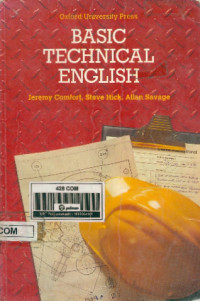Printed
Basic Technical English
Basic Technical English is a reading course for beginner/elementary level students in secondary schools, vocational schools and colleges, or in-company training programs. The main aim of the course is to develop confidence and ability in extracting information from technical manuals and textbooks in a wide range of technical areas including mechanical engineering, electrical engineering, workshop practice, electronics, etc.
The course involves approximately 70-80 hours of classroom teaching. There are 24 units; each unit is divided into 4 sections: 1) PRESENTATION: new language features presented in a technical text, 2) PRACTICE: exploitation of new features and recycling of previous units, 3) DEVELOPMENT: further practice in context of another topic, 4) SUMMARY: sentence patterns, discourse connectors, reference devices, vocabulary.
The teacher's book gives clear and detailed guidance on how to present each unit. It also suggests further ways of extending the exercises, and provides background to the methodology and material that have been selected. A full key is include in the Teacher's Book.
UNIT PAGE TOPIC : EXAMPLE :
1 1 Shapes Squares, circles, etc.
Forms of transport Bikes, planes, etc.
2 4 Vehicle components Gear boxes, Engines, Generators, Batteries.
3 6 Materials Chemical compounds and elements; metals and alloys.
4 9 Geometric shapes Cubes, cylinders, etc.
Rotary systems Gears, pulleys, etc.
5 13 Geometric shapes Pipes, cylinders, etc.
Electric circuits Resistance.
6 16 Rotary systems Gears.
Drills. Cameras Wood and metal
7 21 Cutting tools and Chisels, lathes and milling machines
machines
Vehicle components. Cylinder blocks, sumps, axles, etc.
8 25 Manual operations Jacks, Levers, etc.
Generators Fan belt adjustment
Petrol engines Piston function.
9 29 Manual controls Taps, buttons, etc.
Rotary systems Cranes, pulleys, cooling and lubricating systems.
10 32 Valves Canals, water tanks, petrol engines
11 36 Measuring instruments. Micrometers
Cutting machines lathes
Joining methods soldering, screw-fastening, etc.
12 40 Industrial processes. Diecasting
Steam engines piston and crank
Petrol engines 4 stroke cycle
13 45 Electromagnetism Conductors
Materials metals
Measuring instruments.electrical meters
14 48 Fault finding Electrical ignition
Measuring instruments Dials
Electrical components Generators, transformers
15 53 Materials plastics, metals
Joining methods thermal, mechanical and adhesive
16 57 Electrical connections Multicore wire, batteries
Personal safety
Materials protection corrosion, marking, etc.
17 62 Joining methods riveting
Materials metal properties
18 65 Structural safety beams, girders
Joining methods brazing, welding, etc.
19 69 Industrial processes furnaces
Electronic components rectifiers
20 73 Personal safety
Fault finding riveting
Industrial processes machining, casting and forging
21 77 Thermostatic controls bimetal strip, hot water thermostat, electric iron
22 80 Refrigeration compression refrigerator, refrigerants
Petrol engines combustion process
23 83 Industrial processes metal hardening
Fault finding metal hardening, drill damage
24 87 Fault finding fuel consumption, ignition, electrics.
Ketersediaan
Informasi Detail
- Judul Seri
-
-
- No. Panggil
-
428 COM
- Penerbit
- Hongkong : Oxford University Press., 1983
- Deskripsi Fisik
-
99 hal. : ilus. ; 24 cm
- Bahasa
-
English
- ISBN/ISSN
-
0-19-457382-6
- Klasifikasi
-
428
- Tipe Isi
-
-
- Tipe Media
-
-
- Tipe Pembawa
-
-
- Edisi
-
1
- Subjek
- Info Detail Spesifik
-
-
- Pernyataan Tanggungjawab
-
-
Versi lain/terkait
Tidak tersedia versi lain
Lampiran Berkas
Komentar
Anda harus masuk sebelum memberikan komentar

 Karya Umum
Karya Umum  Filsafat
Filsafat  Agama
Agama  Ilmu-ilmu Sosial
Ilmu-ilmu Sosial  Bahasa
Bahasa  Ilmu-ilmu Murni
Ilmu-ilmu Murni  Ilmu-ilmu Terapan
Ilmu-ilmu Terapan  Kesenian, Hiburan, dan Olahraga
Kesenian, Hiburan, dan Olahraga  Kesusastraan
Kesusastraan  Geografi dan Sejarah
Geografi dan Sejarah